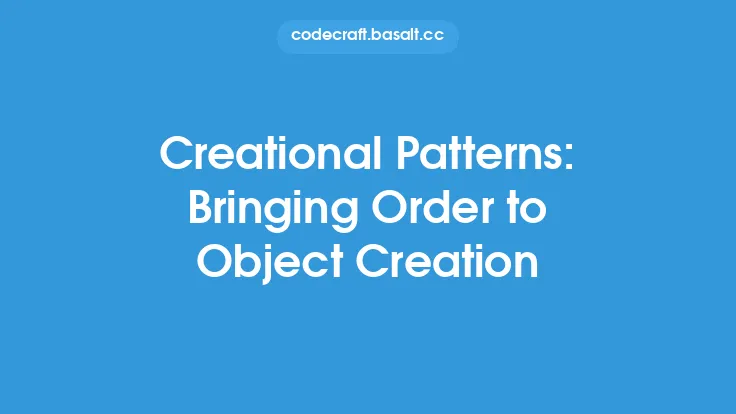When it comes to designing and developing software, one of the key aspects to consider is the creation and management of objects. In object-oriented programming, objects are the building blocks of any application, and how they are created, managed, and interact with each other can greatly impact the overall performance, scalability, and maintainability of the software. Two design patterns that are commonly used to manage objects are the Singleton and Prototype patterns. In this article, we will delve into the details of these two patterns, exploring their definitions, benefits, and use cases, as well as providing guidance on when and how to use them effectively.
Introduction to the Singleton Pattern
The Singleton pattern is a creational design pattern that restricts the instantiation of a class to a single instance. This means that only one object of the class can exist throughout the application, and it provides a global point of access to that object. The Singleton pattern is often used when a single, global instance of a class is required, such as a configuration manager, a logger, or a database connection pool. The benefits of using the Singleton pattern include improved performance, reduced memory usage, and simplified access to the global instance.
Introduction to the Prototype Pattern
The Prototype pattern is a creational design pattern that allows objects to be created by copying an existing object, known as the prototype. This pattern is useful when the type of objects to be created is determined by a prototypical instance, which is cloned to produce new objects. The Prototype pattern is often used in situations where the creation of new objects is expensive or time-consuming, such as when working with complex graphics, simulations, or data models. The benefits of using the Prototype pattern include improved performance, reduced memory usage, and increased flexibility in object creation.
Key Differences Between Singleton and Prototype Patterns
While both the Singleton and Prototype patterns are used to manage objects, they serve different purposes and have distinct characteristics. The Singleton pattern is used to restrict the instantiation of a class to a single instance, whereas the Prototype pattern is used to create new objects by copying an existing object. The Singleton pattern provides a global point of access to the single instance, whereas the Prototype pattern allows for the creation of multiple objects from a prototypical instance. Understanding the differences between these two patterns is crucial in determining which one to use in a given situation.
Use Cases for the Singleton Pattern
The Singleton pattern is commonly used in a variety of scenarios, including:
- Logging: A Singleton logger can be used to log messages throughout the application, providing a global point of access to the logging functionality.
- Configuration management: A Singleton configuration manager can be used to manage application-wide settings and configurations.
- Database connection pooling: A Singleton database connection pool can be used to manage a pool of database connections, providing a global point of access to the connections.
- Caching: A Singleton cache can be used to store and retrieve data, providing a global point of access to the cache.
Use Cases for the Prototype Pattern
The Prototype pattern is commonly used in a variety of scenarios, including:
- Graphics and game development: The Prototype pattern can be used to create multiple instances of game objects, such as characters, vehicles, or obstacles, by cloning a prototypical instance.
- Simulation and modeling: The Prototype pattern can be used to create multiple instances of simulation objects, such as agents, entities, or systems, by cloning a prototypical instance.
- Data modeling: The Prototype pattern can be used to create multiple instances of data models, such as customer profiles, orders, or products, by cloning a prototypical instance.
- User interface components: The Prototype pattern can be used to create multiple instances of user interface components, such as buttons, text fields, or menus, by cloning a prototypical instance.
Implementing the Singleton Pattern
Implementing the Singleton pattern involves creating a class that restricts its instantiation to a single instance. This can be achieved by using a private constructor, a static instance variable, and a public static method to access the instance. The following code snippet illustrates a basic implementation of the Singleton pattern in Java:
public class Singleton {
private static Singleton instance;
private Singleton() {}
public static Singleton getInstance() {
if (instance == null) {
instance = new Singleton();
}
return instance;
}
}
Implementing the Prototype Pattern
Implementing the Prototype pattern involves creating a class that provides a method to clone itself. This can be achieved by using a clone method, which creates a new instance of the class and copies the state of the original object to the new instance. The following code snippet illustrates a basic implementation of the Prototype pattern in Java:
public class Prototype implements Cloneable {
private String name;
public Prototype(String name) {
this.name = name;
}
public Prototype clone() {
try {
return (Prototype) super.clone();
} catch (CloneNotSupportedException e) {
throw new RuntimeException(e);
}
}
}
Best Practices for Using the Singleton and Prototype Patterns
When using the Singleton and Prototype patterns, it is essential to follow best practices to ensure that the patterns are used effectively and efficiently. Some best practices to keep in mind include:
- Use the Singleton pattern sparingly, as it can make the code more difficult to test and maintain.
- Use the Prototype pattern when the creation of new objects is expensive or time-consuming.
- Ensure that the Singleton instance is thread-safe, especially in multi-threaded environments.
- Ensure that the Prototype instance is properly cloned, including all its state and behavior.
- Avoid using the Singleton pattern to manage complex state or behavior, as it can lead to tight coupling and make the code more difficult to maintain.
Conclusion
In conclusion, the Singleton and Prototype patterns are two powerful creational design patterns that can be used to manage objects in software applications. The Singleton pattern restricts the instantiation of a class to a single instance, providing a global point of access to the instance, while the Prototype pattern allows objects to be created by copying an existing object. By understanding the benefits, use cases, and implementation details of these patterns, developers can use them effectively to improve the performance, scalability, and maintainability of their software applications. By following best practices and using these patterns judiciously, developers can create robust, efficient, and maintainable software systems that meet the needs of their users.





